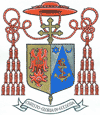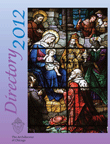
The Cardinal's Column
Francis Cardinal George, O.M.I.
Who is native to America?
Cardinal George's Schedule
- July 8 - 14: Vacation
- July 15: 3 p.m., 100th Anniversary Mass, Our Lady of Perpetual Help, Glenview
- July 16: 10 a.m., Catholic Charities, Kent Residence Dedication, Northlake
- July 17: 10 a.m., Episcopal Council Meeting; 7 p.m., Young Adult Presentation, St. Alphonsus, Chicago
- July 19: 3 p.m., Meeting with Hispanic Ministry Coordinators, Pastoral Center
- July 20: 9 a.m., Management Meeting, Pastoral Center; 6 p.m., Lector Gathering, Holy Name Cathedral

Cardinal's Appointments
June 27, 2007
His Eminence, Francis Cardinal George announces the following appointments:
Pastors
Rev. Joseph Glab, C.R., from administrator of St. Hedwig Parish, North Hoyne, to be the pastor of St. Matthew Parish, Schaumburg, effective July 1.
Rev. Thomas Smithson, SSS, to be the Pastor of SS. Peter and Paul Parish, South Paulina, effective July 1.
Administrator
Rev. Jesus H. Puentes, from administrator of St. Bronislava Parish, South Colfax, to be the administrator of St. Philomena Parish, North Kedvale, effective July 1.
Deans
Rev. Ronald Lewinski to be the dean of deanery I-A while retaining his position as pastor of St. Mary of the Annunciation Parish, Mundelein, effective July 1.
Rev. Patrick Cecil to be the dean of Deanery I-B while retaining his position as pastor of St. Patrick Parish, Wadsworth, effective July 1.
Rev. Michael McGovern to be the dean of Deanery I-C while retaining his position as pastor of St. Mary Church, Lake Forest, effective July 1.
Rev. Edward Fialkowski to be the dean of Deanery I-D while retaining his position as pastor of Our Lady of the Wayside Parish, Arlington Heights, effective July 1.
Rev. Robert Tonelli to be the dean of Deanery I-E while retaining his position as pastor of St. John the Evangelist Parish, Streamwood, effective July 1.
Rev. Bernard Pietrzak to be the dean of Deanery I-F while retaining his position as pastor of St. Raymond De Penafort Parish, Mount Prospect, effective July 1.
Rev. Paul Seaman to be the dean of Deanery IV-A while retaining his position as pastor of St. Pascal Parish, North Melvina, effective July 1.
Rev. Mark Bartosic to be the dean of Deanery IV-C while retaining his position as pastor of St. Frances of Rome Parish, Cicero, effective July 1.
Rev. Thomas Cima to be the dean of Deanery V-A while retaining his position as pastor of St. Michael the Archangel Parish, South Damen, effective July 1.
Rev. Anthony Pizzo, OSA to be the dean of Deanery V-B-East while retaining his position as pastor of St. Rita of Cascia Parish, South Fairfield, effective July 1.
Rev. Theodore Bojczuk to be the dean of Deanery V-B-West while retaining his position as pastor of St. Symphorosa Parish, South Austin, effective July 1.
Rev. William Corcoran to be the dean of Deanery V-D while retaining his position as pastor of St. Linus Parish, Oak Lawn, effective July 1.
Normally, anyone born in a particular city or country is considered native to that place. Native means born there. Yet in the United States we have taken to reserving the adjective “native” to those whose ancestors were in North America before the European discoveries and conquest of the continent. That leaves the many millions of us who were born here and are natives of no other place but are not members of an American Indian tribe without a native place. It would seem to me to be more accurate to speak of American Indians as native pre-Americans, because that drives home the point that is specific to them. They were here first, before this was America. Furthermore, they are conquered peoples, whose collective rights as peoples are established first of all by treaties with the Federal Government, not by the bill of individual rights in the U.S. Constitution. Constitutionally, the American Indians (as they still often call themselves) were wards of the federal government, not U.S. citizens until the time of President Franklin Roosevelt. To assimilate them into one more ethnic or racial group, like Irish Americans or Italian Americans or African Americans, is to ignore their distinctive history and their place in society. It co-opts them into our history by making them just one more immigrant group. Instead, they are tribal and relate to our society as semisovereign entities.
This history of the native peoples’ special relation to the U.S. government and society is little known, and it would be good on the Fourth of July to remind ourselves of it. Even less known is the history of the native peoples with the Catholic Church. A key figure in this relationship was Fr. Peter John De Smet, S.J., a Belgian who came to this country in 1823 in order to preach the Gospel of Jesus Christ to the native peoples. In a sense he was representative of hundreds of other Catholic missionaries, and in another sense he was unique because the years of his ministry coincided with the most dramatic changes in the Indian way of life. His base was the city of St. Louis, Missouri, which became the equipping and starting point for American expansion across the plains and into the Rocky Mountains. As the settlers moved out, the army cleared the land of both buffalo herds and Indian tribes. The disappearance of the buffalo herds made the Indians almost entirely dependent on the government for sustenance and reduced the culture shaped by the buffalo hunt to folklore. As the native way of life came to an end, Fr. De Smet built a unique personal relationship with the Indians. He was instrumental also in forging their new relationship to their conquerors.
With the opening of the Northwest Territories after the Lewis and Clark expedition, President Thomas Jefferson thought to coerce the Indians by commerce rather than by war. The idea was to integrate them into the dominant economy and wean them from dependence on the buffalo. Dependency on manufactured goods would alter their relationship both to the land and to the manufacturers of the goods they would come to desire. Jefferson meant to destroy native culture, but peacefully. It became clear at every point of conflict, however, that land was more important than Indians.
Fr. De Smet’s ministry fell largely between the two “Great Smokes,” the conferences between government and Indian leaders designed to regulate the status of the native peoples as the land was being occupied by adventurers and settlers. The first of these conferences produced the Fort Laramie Treaty of 1851; it opened a corridor through the plains for the settlers to travel west in safety. The last of these conferences produced another Fort Laramie Treaty in 1868, when the Great Plains became legally government property and the reservation system began to be consolidated. As it became clear that cattle and cows would replace buffalo, that farm families would replace quasi-nomadic clans, that medical doctors would replace shamanists and that U.S. law and continental government regulations would replace tribal customs and inter-tribal skirmishes, De Smet’s thinking and ministry changed. In the 1840’s De Smet planned a huge native reduction, modeled on the Jesuit Reductions in Paraguay two centuries earlier, under the assumption that much of the plains would remain free of settlers and could become a Christian Indian empire. In the 1850’s De Smet worked for peaceful coexistence with the Indians under the benign though powerful paternalism of the U.S. government and the protection of the “Great White Father” in Washington. At the close of the 1860’s De Smet thought of bringing officially Indian States into the American Union. At the end of his life it was clear that the native way of life was doomed by the very existence of the American experiment.
Although the disappearance of the native way of life could have been accomplished with less treachery and bloodshed, Indian submission was inevitable. What is equally clear is that it was not the Church but the U.S. government and the American people that destroyed the native way of life. Christianity is compatible with a nomadic way of life; American civilization is not. When the missionaries were co-opted by the government and became, effectively, agents of the government through the residential schools, they became part of a system of cultural suppression. When the missionaries were free to be themselves, they personally assimilated to the native way of life, moving with the Indians on their hunts, gathering with them at their fires. Conversion to Christ, the primary work of the Church, did not demand submission to the U.S. government. Today, when the Church is frequently accused of destroying native cultures, it is good to point out that the resurgence of native languages is often dependent on the dictionaries put together by the first missionaries. They put into writing languages that had never developed a complete system of written literacy. In the Pacific Northwest, where I was first bishop, the native Yakima tribes find help in reconstructing their language from a dictionary put together by the Oblate missionaries a century and a half ago.
In the 1670’s, two centuries before the conquest of the native peoples was completed, the area that is now Chicago was visited by an earlier Jesuit missionary, Fr. Jacques Marquette, and his companion, Louis Joliet, a trader. The removal of the native peoples from the prairies pre-dated their confinement on reservations on the plains, but Fr. Marquette began here our local chapter in the long history of the relationship between American Indians and the Catholic religion. In 1905, the site of the cabin where Fr. Marquette spent the winter of 1674- 1675, at the intersection of Damen Avenue and Twenty-sixth Street and the south branch of the Chicago River, was marked with a cross. Then mayor William Dever named Dec. 4, the anniversary of Marquette’s arrival here in 1674, “Marquette Day” in Chicago. On July 4 and on Dec. 4 and on days in between, the Catholic faith brings God’s revelation to those who can hear it; it is the obligation of each generation of Christians to witness to that faith in their own culture.
In the Archdiocese of Chicago, although the Potawatomi and the Illinois, the Sacs and the Foxes, the Kaskaskia and other native nations were long ago expelled from our State, the Anawim Center at 4750 N. Sheridan Road, under the direction of Sr. Patricia Ann Mulkey, is a small outpost of ministry to the native peoples who live in the city. Urban life is often very hard for the native peoples, whose life is shaped by relationship to the land, and this Center does its best to give hope and the assurances of faith to Catholic Indians and others. It would be anachronistic to romanticize Indian life, which was often as brutal and violent as any; but it is also intellectually dishonest to re-read the history of the American conquest of the land as a story of cultural conflict between Christianity and the pre-American native peoples. God bless you as, together, we pray for our country this Fourth of July. For most of us, Indians and others, it is our native land.
Sincerely yours in Christ,
Francis Cardinal George, OMI
Archbishop of Chicago



